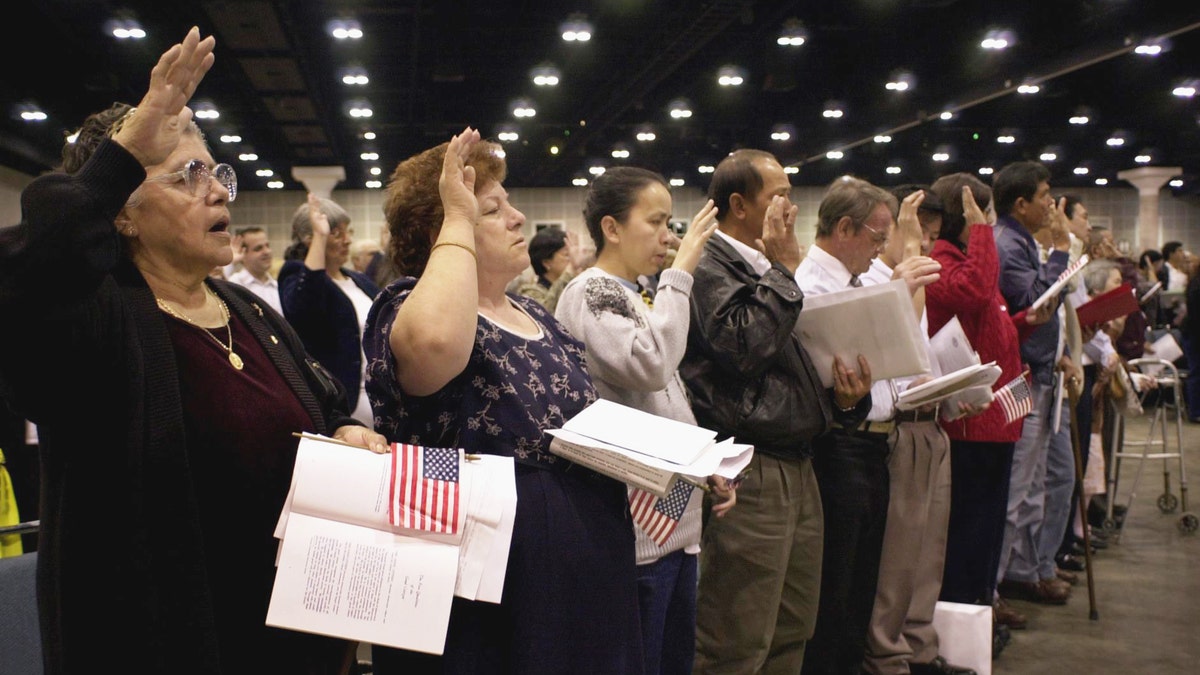
Immigrants from such countries as Mexico, El Salvador, Vietnam, the Philippines and Iran raise their hands as they are sworn in as United States citizens. (2004 Getty Images)
The Central American immigrant population in the United States grew faster than any other from Latin America between 2000 and 2010.
In that 10-year period, the Central American immigrant population grew to 3 million, from 2 million in 2000, according to an analysis by the Migration Policy Institute. The analysis looked at Census and federal immigration data.
“From 1960 to 2011, the number of Central American immigrants and their share of the US immigrant population increased rapidly,” the report said.
There were about 50,000 Central Americans in the U.S. in 1960. The numbers tripled in both the 1970s and 1980s and rose again in the 1990s, according to the report.
Central Americans have been gaining legal permanent residency, commonly referred to as “the green card,” through family petitions.
The report said that in 2011, for example, 82 percent of Central American immigrants obtained U.S. residency through relatives living here, 4 percent got it by qualifying as refugees or political asylees, 3 percent through employment, and the rest through other avenues. The top sending countries in the region were El Salvador, Guatemala, and Honduras.
MPI spokesman Burke Speaker said it is unclear how many of the Central Americans are documented and how many are undocumented.
More than half of all Central American immigrants reside in three states: California, Texas, and Florida.
Roughly 65 percent of all legal immigrants gain admission to the United States through relatives, and 14 percent do so through employment, according to the MPI.
The MPI report comes as family-based admissions have become a point of contention in the debate over how to reform the U.S. immigration system. Those who favor more strict immigration laws argue that family-based eligibility should be tightened in favor of making skills a larger part of who gains admission into the United States.
A bipartisan group of U.S. senators working on an immigration reform measure are developing plans that would make it more difficult for people with U.S. citizen relatives to gain permanent residency here. At the same time, the plans would expand opportunities for high-skilled people to come to the United States.
The move is controversial, especially among advocates for more lenient immigration policies. They argue that family-based immigration has long been a bedrock of the country’s system for admitting foreign nationals, and that keeping families together benefits the larger society.
Those who favor skills as a criteria say immigration should meet the economic needs of the country.
The report noted that Central American immigrants tend to be less proficient in English, more likely to live in poverty and to be of working age.
About 1.5 million children under the age of 18 resided in households with at least one Central-American born parent, the report said, adding that it represents 9 percent of all children of immigrants.
"The reality is that a lot of Mexicans have sort of given up looking for work in the U.S. and have started to return home,” said David Shirk, director of the Trans-Border Institute at the University of San Diego, in an Associated Press article last year. “But for Central Americans, the conditions may be even more desperate that the ones we're seeing in Mexico."
Follow us on twitter.com/foxnewslatino
Like us at facebook.com/foxnewslatino
